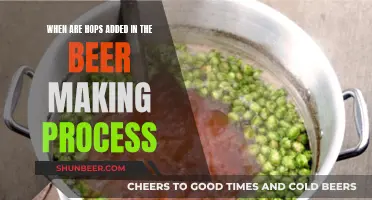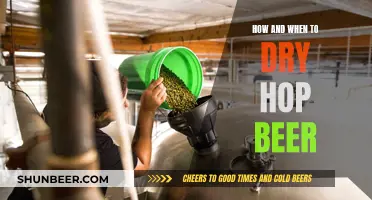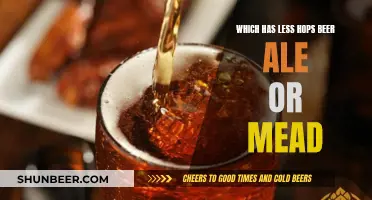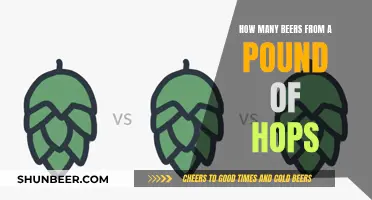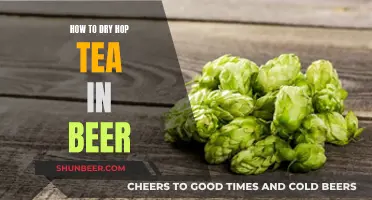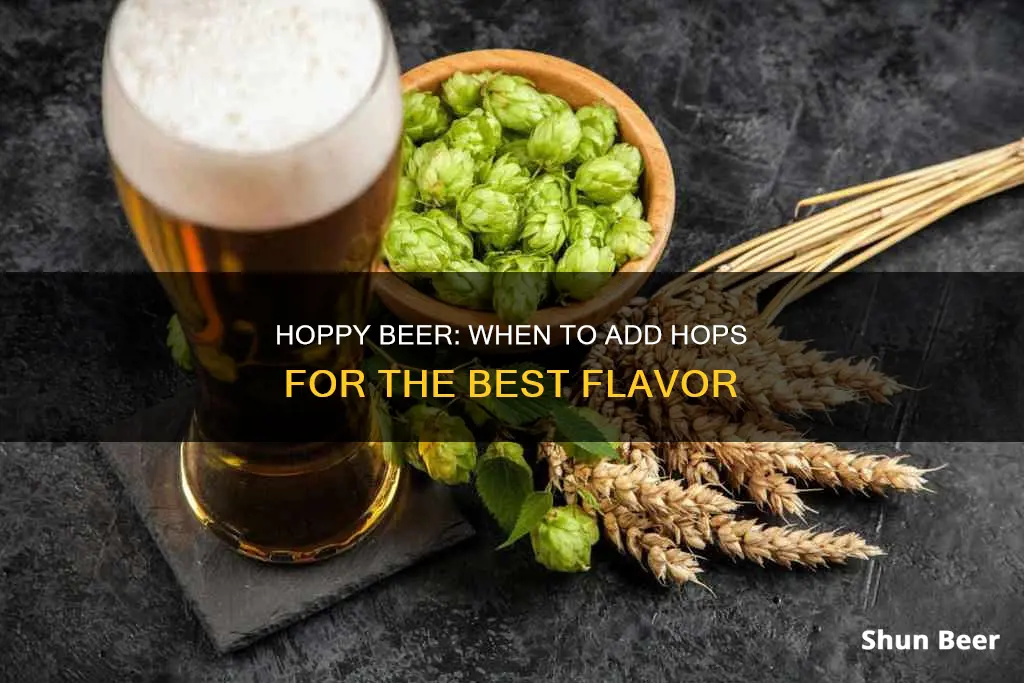
Hops are the flowers of the hop plant, Humulus lupulus, and are used to add flavour and aroma to beer. They are also a natural preservative, helping beer to last longer. Hops are added to the beer-making process at different stages, depending on the desired effect. They can be added during the boil, or after fermentation, in a process known as dry hopping. When hops are boiled, they release alpha acids, which are the primary bittering agent in beer, balancing the sweetness of the malt. However, boiling hops for too long can destroy the delicate essential oils that give hops their distinctive flavours and aromas. Therefore, when hops are added for flavour and aroma, they are usually boiled for a shorter duration or added after the boil, as in dry hopping.
What You'll Learn

Hops are added during the three stages of wort: bittering, flavouring, and aroma
Hops are added to the wort during the three stages of the brewing process: bittering, flavouring, and aroma. These stages are associated with the role they play in the beer, and not with a specific type of hop. The same hop variety can be used for bittering, flavouring, and aroma.
All beers have at least one hop addition for bitterness to balance the sweetness of the malt. Without the bitterness from the hops, beer would taste syrupy-sweet. Hops are also a natural preservative and will help beer last longer. Bittering hops are added once the wort has been collected in the kettle and a rolling boil has been achieved. They are usually boiled for 60 minutes, although some recipes call for as little as 30 minutes.
Flavouring hops are added with between 15 and 30 minutes remaining in the boil. In this time frame, very little bitterness will be extracted from the hops, but a crisp hoppy flavour will be imparted.
Aroma hops are added during the last 5 to 15 minutes of the boil, or at flame out (when the kettle is removed from the heat). The hop oils that give the beer its aroma are extremely volatile and will be driven off in the steam of the boil almost immediately. Adding hops at flame out will produce the maximum amount of aroma.
Adding hops at different times gives the beer more complexity. Most recipes will specify when to add the hops, either in time from the start of the boil or the time left in the boil.
The Essential Ingredient in Beer: Hops or Not?
You may want to see also

Hops are added to balance the sweetness of the malt
Hops are added to beer to balance the sweetness of the malt. Malt adds sweetness and alcohol content to beer, and hops add bitterness to balance this out. The average American Light Lager, such as Budweiser, Bud Light, and Coors Lite, has an International Bitterness Unit (IBU) of 8 to 12, and they are low in alcohol (less than 5% alcohol by volume). They are well-balanced and easy to drink because they are low in alcohol and lightly hopped.
India Pale Ales (IPAs), on the other hand, will be at least 60 IBUs, and some can go as high as 80 IBUs or more. To balance this out, more malt is needed in the brew than in an average pale ale; malt adds sweetness to counterbalance the abundance of bitterness from the hops. Malt also adds more sugar, which yeast converts into higher alcohol content. Consequently, a well-balanced IPA will have an alcohol content of nearly 7% ABV and maybe as high as 9% or slightly more.
Hops are added to beer in three stages: bittering, flavour, and aroma. However, not all beers will have three additions; some may have only one, while others may have up to five or six. All beers, though, will have at least one hop addition for bitterness.
Bittering hops are added once the wort has been collected in the kettle and a rolling boil has been achieved. They are usually boiled for 60 minutes, although some recipes may call for as little as 30 minutes. All beers have bittering hops because without the bitterness from the hops, the beer would taste syrupy-sweet. Another benefit is that hops are a natural preservative and will help the beer last longer.
Flavoring hops are added with between 15 and 30 minutes remaining in the boil. During this time, very little bitterness will be extracted from the hops, but a crisp hoppy flavor will be imparted.
Aroma hops are added during the last 5 minutes of the boil or at flameout (when the kettle is removed from the heat). The hop oils that give the beer its aroma are extremely volatile and will be driven off in the steam of the boil almost immediately. Adding hops at flameout will produce the maximum amount of aroma.
Hops in Beer: Necessary or Overrated?
You may want to see also

Hops are a natural preservative
The first documented use of hops in beer was in the 9th century, though Hildegard of Bingen, 300 years later, is often cited as the earliest documented source. Before this period, brewers used a "gruit", composed of various bitter herbs and flowers, including dandelion, burdock root, marigold, horehound, ground ivy, and heather. However, traditional herb combinations for beers were abandoned when it was noticed that beers made with hops had a longer shelf life.
Hops contain antibacterial compounds such as lupulin, a yellowish, waxy substance that imparts flavour and aroma to beer. Lupulin contains lupulone and humulone, which possess antibiotic properties that suppress bacterial growth and favour the growth of brewer's yeast. Hops also contain isohumulone, which disrupts the membranes of lactobacilli.
The amount of hops used can also impact the preservative effect. Increasing the amount of hops in the boil can improve the shelf life and sturdiness of beer by protecting it from a wide range of bacterial foes. However, using too many hops can result in an undesirable vegetative flavour.
Different varieties of hops may also have varying preservative effects. Some sources speculate the existence of an unknown "Factor X" in hops, which is responsible for their preservative power. While the exact nature of Factor X is unknown, it is believed to be related to the amount of hops used and is only released when hops are boiled, not when they are dry hopped.
Identifying Hops in Beer: A Guide to Flavor and Aroma
You may want to see also

Hops are added during fermentation, also known as dry hopping
Hops are added to beer during the fermentation process, also known as dry hopping. This technique is used to enhance the beer's aromatic qualities and amplify its hoppy flavours. Dry hopping involves adding hops to the beer in the fermenter, secondary vessel, or keg. This is in contrast to traditional hopping, where hops are added to the boil or whirlpool, exposing them to high temperatures.
Dry hopping is a popular technique among brewers of hazy IPAs, and it can be done during active primary fermentation or at the beginning of fermentation. By dry hopping during active fermentation, brewers may allow the yeast to metabolise any oxygen introduced before it can cause negative effects. However, there is a potential downside to this technique, as hop compounds can be bound to the yeast and dropped out of the beer after fermentation, reducing the amount of polyphenols in the finished product.
The temperature of the beer during dry hopping also impacts the rate at which hop compounds are extracted. When dry hopping at typical ale fermentation temperatures (18-20°C), the rate of extraction is increased, and full extraction can be achieved within 24 hours. On the other hand, dry hopping at cooler temperatures (such as 14°C) slightly decreases the rate of extraction, and full extraction may take up to 2-3 days.
Dry hopping can also cause additional fermentation, a phenomenon known as "hop creep." This occurs because hops contain enzymes that can break down unfermentable sugars (dextrins) in the beer into fermentable sugars, which yeast then consumes. The amount of additional fermentation caused by dry hopping depends on factors such as contact time, temperature, yeast strain, and the amount of hops added.
To avoid oxidation when dry hopping, brewers can use techniques such as sealing the fermenter and purging the headspace with CO2 or adding the dry hops to a separate vessel that has been purged with CO2 before transferring the beer.
Enhancing Beer Flavor: Increasing Hops for Better Taste
You may want to see also

Hops are added after fermentation
Hops are added to beer at different stages of the brewing process, depending on the role they are playing. The three stages are bittering, flavouring, and aroma. Hops are typically added to the wort in all three stages during the boil. However, in some cases, hops are added after fermentation. This technique is called dry hopping.
Dry hopping is the process of adding hops to beer after fermentation has begun. It is done to impart a fresh hop aroma and unique taste to the beer without adding any bitterness. The hops are added when the fermentation starts to slow down, usually three to four days after fermentation has begun. This timing ensures that the organisms on the hops can't survive, as the beer's pH has dropped, and the alcohol serves to kill them. Additionally, there is a healthy yeast population in the beer at this stage, which competes with other organisms.
Dry hopping preserves the flavour and aroma from the hops' oils, which are distinct from the alpha acids that give the beer its bitterness. These oils are volatile and will evaporate during the boiling process, so adding hops after fermentation ensures that these delicate compounds are retained. The longer the boil time, the more oils are lost. Hops added at the beginning of the boil for bittering lose almost all of their oils, while those added near the end retain some but still lose a significant amount.
There are different techniques for dry hopping, such as adding hops to the serving cask, keg, or fermenter. When adding hops to the fermenter, it is essential to use a mesh bag to contain the hops and weights to ensure they sink into the beer. The type of hops used for dry hopping can be either pellets or whole hops, each with its advantages and disadvantages. Pellets are more convenient and readily available, while whole hops provide a slower release of oils, resulting in a more constant aroma over time.
The amount of hops used for dry hopping depends on the desired hoppiness and the variety of hops chosen. Some hops have a more potent aroma than others, and the oil content can vary. It is recommended to use at least one ounce of hops for a five-gallon batch and adjust from there.
Importing Azacca Hops to BeerSmith: A Step-by-Step Guide
You may want to see also
Frequently asked questions
Hops are the flowers of the female hop plant, Humulus lupulus. They are used to balance the sweetness of the malt in beer and are packed with oils and flavours.
Beer hops are typically added to wort in three stages during the boil: bittering, flavour, and aroma. However, not all beers will have three additions; some may have only one, while others may have up to five or six.
Hops are categorised based on their geography of origin: Noble hops from Germany and the Czech Republic, American hops from the United States, and English hops from England. Within each category, there are numerous strains with distinct flavour and aroma profiles.


